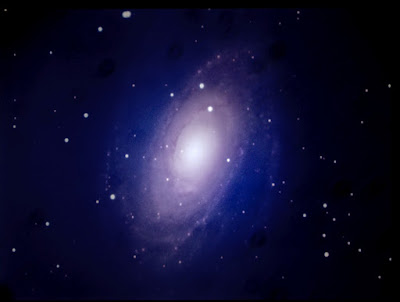Physics Photo of the Week
Physics Photo of the Week
March 31, 2023
M81 Bode's Galaxy - Astrophoto by D. Collins (College View Observatory)
Charles Messier was a comet hunter. Astronomers were more interested in tracking comets because they were known to be Solar System objects that moved from night to night among the stars. In scanning the skies he needed a quick reference of the faint fuzzy objects to avoid studying - they didn't move - and he didn't want to waste time on these nebulae. Astronomers over 200 years ago had no idea that these nebulae consisted of that resembled sprial shaped clouds that were clearly out there beyond the Solar System among the stars. It is highly ironic that these objects to be avoided have turned out to be the most interesting objects of modern astronomy!
The monochrome photo at right shows M31 with much more detail - especially the much further extent of the faint spiral arms as well as clouds of both stars and dust. The monochrome photo was taken in 2021 at College View Observatory. Astronomers thought that these spiral-shaped objects (clouds) were relatively close objects scattered among the stars.
It wasn't until the early 20th century that Edwin Hubble used the newly-completed 100 inch Hooker telescope on Mt. Wilson, California - the worlds largest telescope at the time, and6 established the true nature of these spiral objects. Hubble found variable stars in the galaxies - mostly with the closer Andromeda galaxy. These variables stars, called Cepheid Variables varied in brightness from night-to-night with a regular period or cycle time. The pulsating period depended on the mass of the variable star. The larger the mass, the longer the cycle time. This is basically the effect that a larger mass has more inertia and takes longer to cycle in its periodic pulsations. Because the more massive stars are bigger and brighter, the cycle time for the Cepheid stars is an indicator of the intrinsic average brightness of the stars. Thus Hubble measured the cycle time for a number of Cepheid stars in these nebulae and found that the cycle times were exceedingly long - several weeks. This indicated that the stars were very bright due to the intrinsic brightness relationship between the cycle-time and mass. With this information astronomers, and current astronomy students, can use a simple formula to calculate the distance to the star by measuring the apparent brightness in a telescope, measure it's cycle time or period, which determines the absolute brightness. The absolute brightness of a star is an intrinsic property of the star. On the other hand the brightness measured with a telescope is called the apparent brightness. The further away the star is from Earth, the fainter the apparent brightness according to a simple well-know mathematical equation called the "inverse square law", and astronomers and their students can then easily calculate the distance to the stars.
 Hubble's results were surprising. Most of the visible stars and the stars visible in small telescopes were known to be between 10 and 500 light years distant. The stars in the spiral nebulae were millions of light years further away than any known stars! Bode's Galaxy is a whopping 12 million light years distant. The closest such galaxy to the Solar System is the Andromeda Galaxy (left), where Hubble first found the Cepheid "indicator" stars was found to be about 2 million light years distant about 1/10 the distance to Bode's galaxy. The Andromeda Galaxy looks much smaller than Bode's galaxy in this photo, mainly because the photograph was taken with a much smaller telescope at the College View Observatory. The Andromeda Galaxy taken with the same camera on the main telescope at College View, is about 3 times the field of view across. The two galaxies are about the same physical size and the same number of stars (about 100 billion stars!). The photo here of the Andromeda Galaxy was made in the fall of 2016.
Hubble's results were surprising. Most of the visible stars and the stars visible in small telescopes were known to be between 10 and 500 light years distant. The stars in the spiral nebulae were millions of light years further away than any known stars! Bode's Galaxy is a whopping 12 million light years distant. The closest such galaxy to the Solar System is the Andromeda Galaxy (left), where Hubble first found the Cepheid "indicator" stars was found to be about 2 million light years distant about 1/10 the distance to Bode's galaxy. The Andromeda Galaxy looks much smaller than Bode's galaxy in this photo, mainly because the photograph was taken with a much smaller telescope at the College View Observatory. The Andromeda Galaxy taken with the same camera on the main telescope at College View, is about 3 times the field of view across. The two galaxies are about the same physical size and the same number of stars (about 100 billion stars!). The photo here of the Andromeda Galaxy was made in the fall of 2016.
======================================================================
Physics Photo of the Week is published weekly during the academic year on Fridays by the Warren Wilson College Physics Department. These photos feature interesting phenomena in the world around us. Students, faculty, and others are invited to submit digital (or film) photographs for publication and explanation. Atmospheric phenomena are especially welcome. Please send any photos to dcollins@warren-wilson.edu.
All photos and discussions are copyright by Donald Collins or by the person credited for the photo and/or discussion. These photos and discussions may be used for private individual use or educational use. Any commercial use without written permission of the photoprovider is forbidden.





Comments
Post a Comment